The AMD Ryzen Threadripper 1950X and 1920X Review: CPUs on Steroids
by Ian Cutress on August 10, 2017 9:00 AM ESTCPU Rendering Tests
Rendering tests are a long-time favorite of reviewers and benchmarkers, as the code used by rendering packages is usually highly optimized to squeeze every little bit of performance out. Sometimes rendering programs end up being heavily memory dependent as well - when you have that many threads flying about with a ton of data, having low latency memory can be key to everything. Here we take a few of the usual rendering packages under Windows 10, as well as a few new interesting benchmarks.
All of our benchmark results can also be found in our benchmark engine, Bench.
Corona 1.3: link
Corona is a standalone package designed to assist software like 3ds Max and Maya with photorealism via ray tracing. It's simple - shoot rays, get pixels. OK, it's more complicated than that, but the benchmark renders a fixed scene six times and offers results in terms of time and rays per second. The official benchmark tables list user submitted results in terms of time, however I feel rays per second is a better metric (in general, scores where higher is better seem to be easier to explain anyway). Corona likes to pile on the threads, so the results end up being very staggered based on thread count.
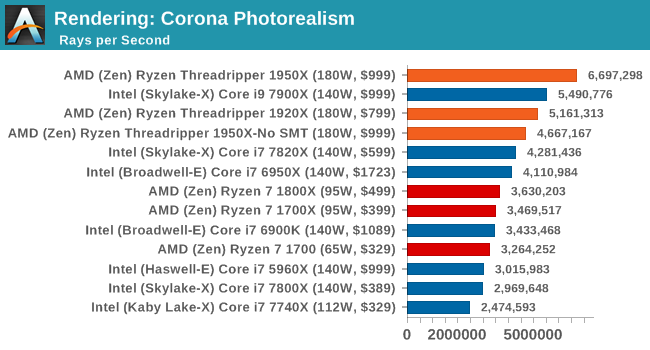
Corona loves threads.
Blender 2.78: link
For a render that has been around for what seems like ages, Blender is still a highly popular tool. We managed to wrap up a standard workload into the February 5 nightly build of Blender and measure the time it takes to render the first frame of the scene. Being one of the bigger open source tools out there, it means both AMD and Intel work actively to help improve the codebase, for better or for worse on their own/each other's microarchitecture.
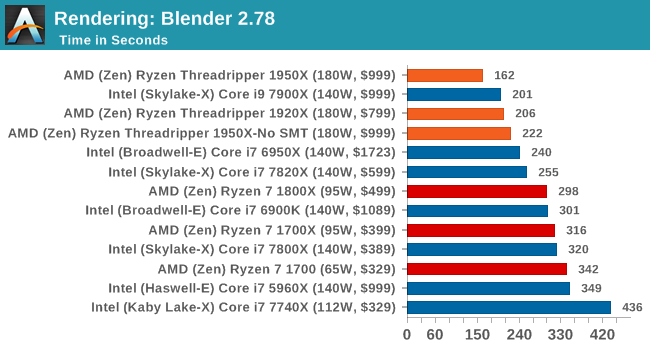
Blender loves threads and memory bandwidth.
LuxMark v3.1: Link
As a synthetic, LuxMark might come across as somewhat arbitrary as a renderer, given that it's mainly used to test GPUs, but it does offer both an OpenCL and a standard C++ mode. In this instance, aside from seeing the comparison in each coding mode for cores and IPC, we also get to see the difference in performance moving from a C++ based code-stack to an OpenCL one with a CPU as the main host.
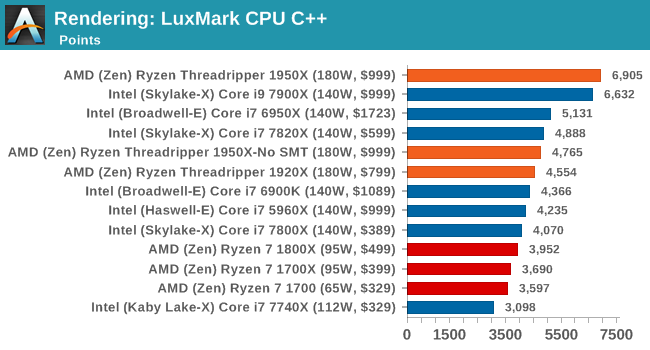
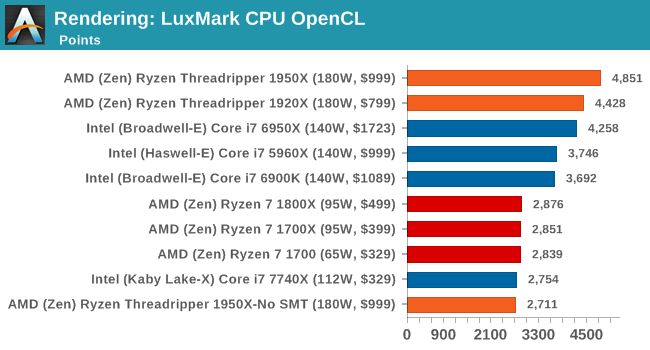
Like Blender, LuxMark is all about the thread count. Ray tracing is very nearly a textbook case for easy multi-threaded scaling. Though it's interesting just how close the 10-core Core i9-7900X gets in the CPU (C++) test despite a significant core count disadvantage, likely due to a combination of higher IPC and clockspeeds.
POV-Ray 3.7.1b4: link
Another regular benchmark in most suites, POV-Ray is another ray-tracer but has been around for many years. It just so happens that during the run up to AMD's Ryzen launch, the code base started to get active again with developers making changes to the code and pushing out updates. Our version and benchmarking started just before that was happening, but given time we will see where the POV-Ray code ends up and adjust in due course.
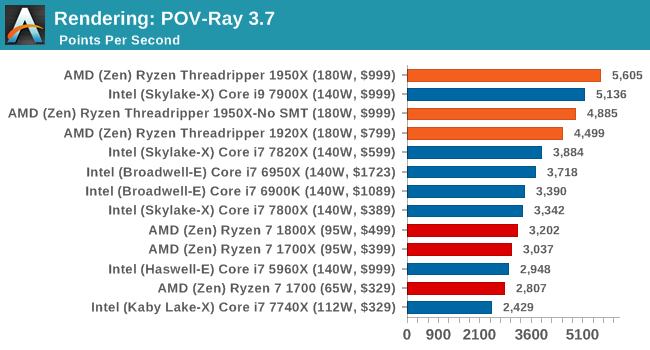
Similar to LuxMark, POV-Ray also wins on account of threads.
Cinebench R15: link
The latest version of CineBench has also become one of those 'used everywhere' benchmarks, particularly as an indicator of single thread performance. High IPC and high frequency gives performance in ST, whereas having good scaling and many cores is where the MT test wins out.
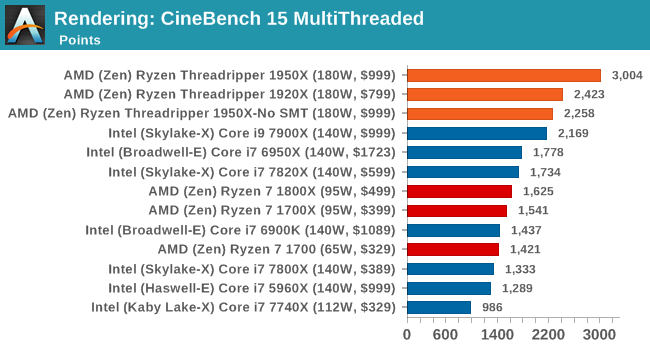
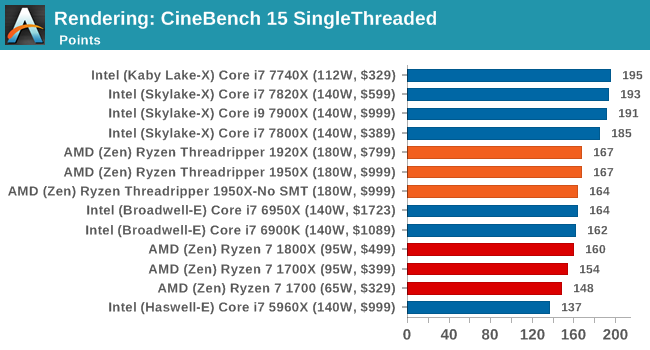
Intel recently announced that its new 18-core chip scores 3200 on Cinebench R15. That would be an extra 6.7% performance over the Threadripper 1950X for 2x the cost.










347 Comments
View All Comments
launchcodemexico - Thursday, August 10, 2017 - link
Why did you end all the gaming review sections with something like "Switching it to Game mode would have made better numbers..."? Why didn't you run the benchmarks in Gaming mode in the first place?Ian Cutress - Thursday, August 10, 2017 - link
Gaming mode is not default, and we run gaming mode alongside the default - there's two sets of values in each graming test.DanNeely - Thursday, August 10, 2017 - link
You might want to call that out more clearly in the text. I also missed that you have two sets of 1950X results; and probably wouldn't've figured out what the -G suffix meant without a hint.Ian Cutress - Thursday, August 10, 2017 - link
I mentioned it in the Game vs Creator mode page, but I'll propagate it through.lordken - Thursday, August 10, 2017 - link
read before you complain, it is stated at beginning of the review that -G is for game mode...DanNeely - Thursday, August 10, 2017 - link
Especially during the work day a lot of people just are doing quick glances at the most interesting parts. I'll end to end read it sometime tonight.mapesdhs - Thursday, August 10, 2017 - link
If people quick-glance, that's their problem for missing key info. :D When learning about something as new as this, I read everything. Otherwise, it's like the tech equivalent of crossing a road while gawping at a phone. :}Last time I read so much about a new CPU launch was Nehalem/X58.
Ian.
smilingcrow - Thursday, August 10, 2017 - link
It seemed really clear to me but for people who didn't read the long text on NUMA etc maybe not.The dangers of skimming!
mapesdhs - Friday, August 11, 2017 - link
Indeed. :D Reminds me of when a long time ebay seller told me that long item decriptions are pointless, because most bidders only read the first paragraph, often only the first sentence.Ian Cutress - Thursday, August 10, 2017 - link
The test suite is a global glove: rather than have 20 tests for each segment, it's a global band of 80 tests for every situation. Johan does different tests as his office is several hundred miles away from where I am (and we're thousands of miles away from any other reviewer).For the gaming benchmarks, there are big differences in 99th percentile frame rates and Time Under analysis. As games become more and more GPU bottlenecked for average frame rates, this is where the differentiation point is. It's a reason why we still test 1080p as well. With regards the AI test, I've asked the Civ team repeatedly to make the AI test accessible from the command line so I can rope it into my testing scripts easily (they already do it with the main GPU test). But like many other game studios, getting them to unlock a flag is a frustrating endeavor when they don't even respond to messages.